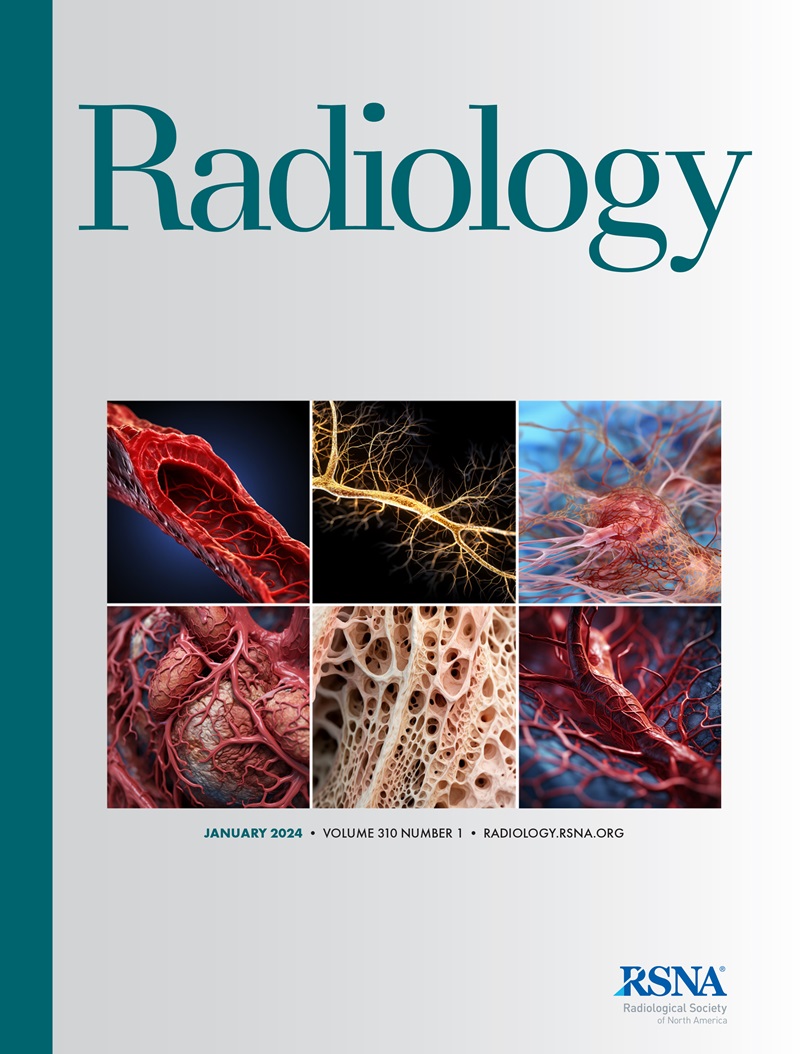Anton R Banta, Raimondo D'Ambrosio, Christof Karmonik, Sunil Mathur, Eugene V Golanov, Angelique Regnier-Golanov, Behnaam Aazhang, Gavin W Britz
求助PDF
{"title":"Quantification of Perivascular Flow Dynamics of Human Cerebrospinal Fluid Along Major Arteries Using Phase-Contrast MRI.","authors":"Anton R Banta, Raimondo D'Ambrosio, Christof Karmonik, Sunil Mathur, Eugene V Golanov, Angelique Regnier-Golanov, Behnaam Aazhang, Gavin W Britz","doi":"10.1148/radiol.243521","DOIUrl":null,"url":null,"abstract":"<p><p>Background Dysfunction in cerebrospinal fluid (CSF) flow dynamics is linked to several neurologic disorders. Although phase-contrast MRI has been used to measure them in the brain, studies in the perivascular space are lacking. Purpose To develop a pipeline of image processing algorithms using contrast-unenhanced 7-T phase-contrast MRI to locate and quantify human brain CSF dynamics along the perivascular space of major arteries and their branches. Materials and Methods In this prospective, single-center study, data were collected from healthy participants, enrolled consecutively, who underwent contrast-unenhanced 7-T phase-contrast MRI at the Houston Methodist Research Institute between February 2020 and July 2023. Data preprocessing included skull removal and contrast enhancement. Vessel detection was achieved by using a chained hysteresis algorithm with two tunable parameters: a high threshold for identifying vessel pixels and a low threshold for image noise cutoff. Perivascular space was detected using a dilation algorithm. CSF velocity was measured in the cerebral aqueduct and three manually segmented perivascular regions: region 1 (internal carotid artery and M1 branch of middle cerebral artery [MCA]), region 2 (M2 segment of MCA), and region 3 (distal cortical branches of MCA or M3 segment). Linear mixed-effects models were calculated between CSF velocity curves in the aqueduct and perivascular spaces to assess their relationship. Two-tailed Mann-Whitney <i>U</i> and <i>F</i> tests were used to assess differences in CSF velocity across two age groups (age 20-39 years and 40-59 years). Results A total of 28 participants (mean age, 40 years ± 11 [SD]; 14 male and 14 female participants) were included. A linear mixed-effects model showed a positive association between aqueduct and perivascular CSF velocity in three regions along the MCA (0.013 cm/sec [<i>P</i> < .001], 0.024 cm/sec [<i>P</i> < .001], and 0.010 cm/sec [<i>P</i> < .001]). Additionally, the height (0.06 vs 0.16 cm/sec; <i>P</i> = .002) and SD (0.02 vs 0.05 cm/sec; <i>P</i> < .001) of the perivascular CSF velocity curve in the distal cortical branches of the MCA differed between the two age groups. Conclusion A semiautomated pipeline of algorithms using phase-contrast MRI was developed to locate and quantify age-dependent human CSF dynamics along the perivascular spaces of major brain arteries. © RSNA, 2025 <i>Supplemental material is available for this article.</i></p>","PeriodicalId":20896,"journal":{"name":"Radiology","volume":"316 3","pages":"e243521"},"PeriodicalIF":15.2000,"publicationDate":"2025-09-01","publicationTypes":"Journal Article","fieldsOfStudy":null,"isOpenAccess":false,"openAccessPdf":"","citationCount":"0","resultStr":null,"platform":"Semanticscholar","paperid":null,"PeriodicalName":"Radiology","FirstCategoryId":"3","ListUrlMain":"https://doi.org/10.1148/radiol.243521","RegionNum":1,"RegionCategory":"医学","ArticlePicture":[],"TitleCN":null,"AbstractTextCN":null,"PMCID":null,"EPubDate":"","PubModel":"","JCR":"Q1","JCRName":"RADIOLOGY, NUCLEAR MEDICINE & MEDICAL IMAGING","Score":null,"Total":0}
引用次数: 0
引用
批量引用
Abstract
Background Dysfunction in cerebrospinal fluid (CSF) flow dynamics is linked to several neurologic disorders. Although phase-contrast MRI has been used to measure them in the brain, studies in the perivascular space are lacking. Purpose To develop a pipeline of image processing algorithms using contrast-unenhanced 7-T phase-contrast MRI to locate and quantify human brain CSF dynamics along the perivascular space of major arteries and their branches. Materials and Methods In this prospective, single-center study, data were collected from healthy participants, enrolled consecutively, who underwent contrast-unenhanced 7-T phase-contrast MRI at the Houston Methodist Research Institute between February 2020 and July 2023. Data preprocessing included skull removal and contrast enhancement. Vessel detection was achieved by using a chained hysteresis algorithm with two tunable parameters: a high threshold for identifying vessel pixels and a low threshold for image noise cutoff. Perivascular space was detected using a dilation algorithm. CSF velocity was measured in the cerebral aqueduct and three manually segmented perivascular regions: region 1 (internal carotid artery and M1 branch of middle cerebral artery [MCA]), region 2 (M2 segment of MCA), and region 3 (distal cortical branches of MCA or M3 segment). Linear mixed-effects models were calculated between CSF velocity curves in the aqueduct and perivascular spaces to assess their relationship. Two-tailed Mann-Whitney U and F tests were used to assess differences in CSF velocity across two age groups (age 20-39 years and 40-59 years). Results A total of 28 participants (mean age, 40 years ± 11 [SD]; 14 male and 14 female participants) were included. A linear mixed-effects model showed a positive association between aqueduct and perivascular CSF velocity in three regions along the MCA (0.013 cm/sec [P < .001], 0.024 cm/sec [P < .001], and 0.010 cm/sec [P < .001]). Additionally, the height (0.06 vs 0.16 cm/sec; P = .002) and SD (0.02 vs 0.05 cm/sec; P < .001) of the perivascular CSF velocity curve in the distal cortical branches of the MCA differed between the two age groups. Conclusion A semiautomated pipeline of algorithms using phase-contrast MRI was developed to locate and quantify age-dependent human CSF dynamics along the perivascular spaces of major brain arteries. © RSNA, 2025 Supplemental material is available for this article.
用相衬MRI定量测定人脑脊液沿大动脉的血管周围流动动力学。
背景:脑脊液(CSF)流动动力学功能障碍与几种神经系统疾病有关。虽然相衬MRI已经被用来测量大脑中的它们,但在血管周围空间的研究是缺乏的。目的:开发一套基于非增强7-T相位对比MRI的图像处理算法,沿大动脉及其分支血管周围空间定位和量化人脑脑脊液动态。材料和方法在这项前瞻性单中心研究中,数据收集自健康参与者,连续入组,于2020年2月至2023年7月在休斯顿卫理公会研究所接受非增强7-T相对比MRI检查。数据预处理包括颅骨去除和对比度增强。血管检测通过链式滞后算法实现,该算法具有两个可调参数:用于识别血管像素的高阈值和用于图像噪声截断的低阈值。采用扩张算法检测血管周围空间。在脑导水管和人工分割的三个血管周围区域测量脑脊液流速:1区(颈内动脉和大脑中动脉M1支)、2区(大脑中动脉M2段)和3区(大脑中动脉远端皮质支或M3段)。计算输水管道和血管周围空间的脑脊液速度曲线的线性混合效应模型,以评估它们之间的关系。采用双尾Mann-Whitney U和F检验评估两个年龄组(20-39岁和40-59岁)脑脊液流速的差异。结果共纳入28例患者(平均年龄40岁±11 [SD],男14例,女14例)。线性混合效应模型显示,在中脑动脉的三个区域,导水管和血管周围CSF速度呈正相关(0.013 cm/sec [P < .001], 0.024 cm/sec [P < .001]和0.010 cm/sec [P < .001])。此外,两年龄组MCA远端皮层分支血管周围CSF速度曲线的高度(0.06 vs 0.16 cm/sec, P = 0.002)和SD (0.02 vs 0.05 cm/sec, P < 0.001)存在差异。结论:基于相位对比MRI的半自动化算法可以定位和量化年龄相关的人脑脊液沿大动脉血管周围间隙的动态变化。©RSNA, 2025本文可获得补充材料。
本文章由计算机程序翻译,如有差异,请以英文原文为准。

 求助内容:
求助内容: 应助结果提醒方式:
应助结果提醒方式:


